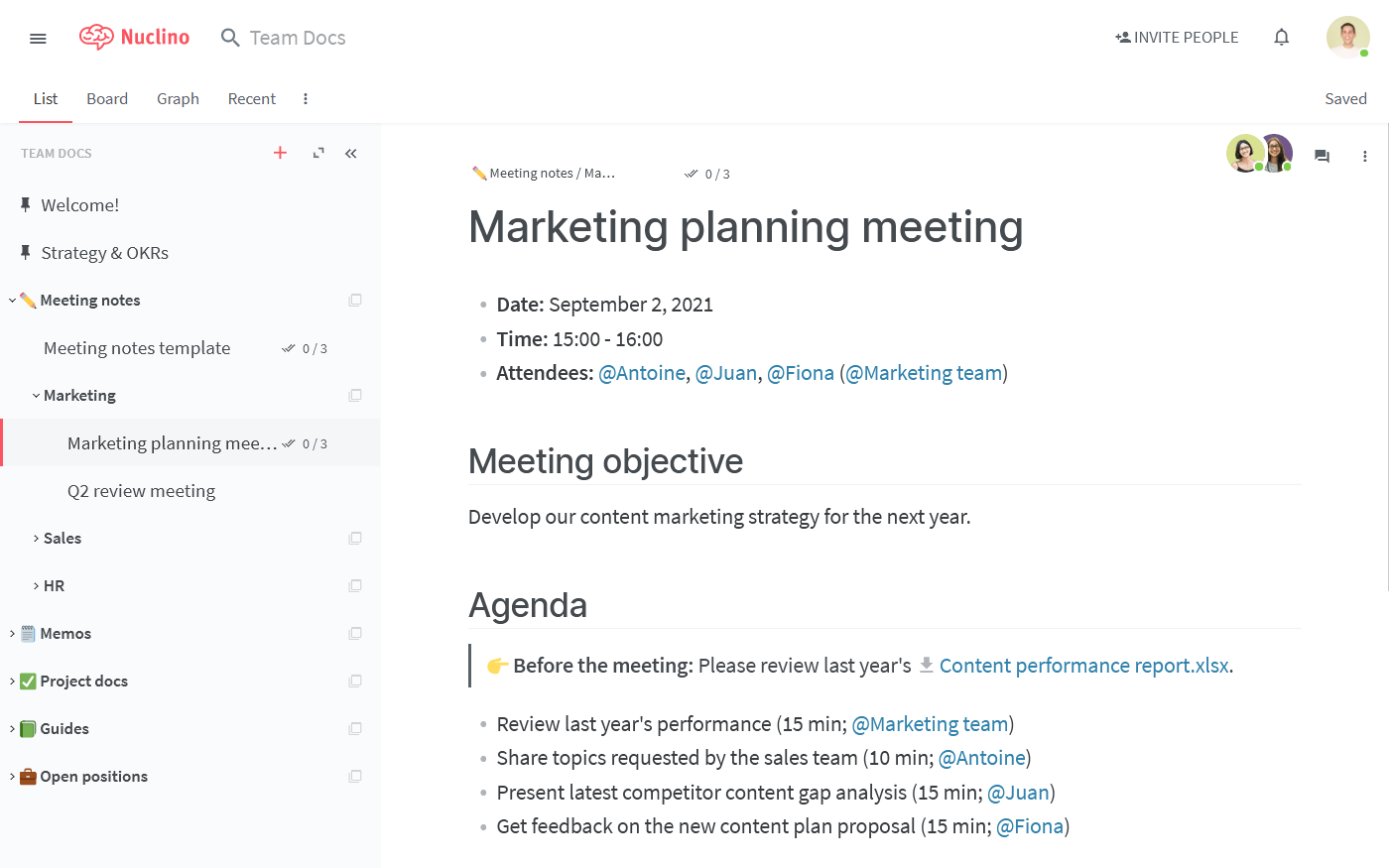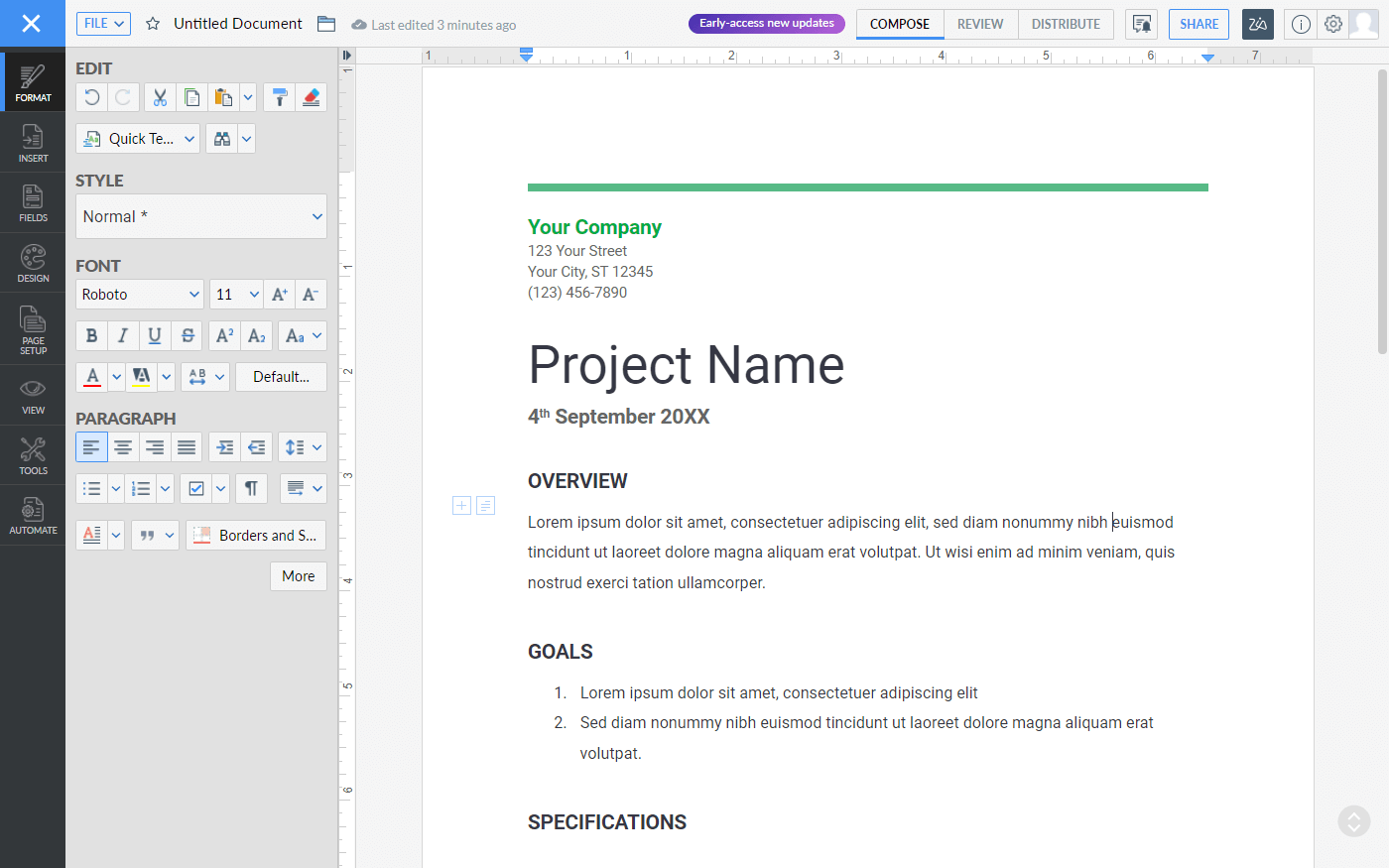Best Document Collaboration Tools in 2025
Learn more about your options and find the best document collaboration software for your team.
A fundamental part of team collaboration revolves around working with documents – sharing team meeting notes, collaborating on press releases, creating technical documentation, writing project plans, noting down lessons learned, and so on. Communicating asynchronously through thoughtful long-form write-ups can also be a more efficient alternative to meetings and real-time chat.
Quite often, however, teams don't have a structured approach to it. Important documents get scattered across inboxes, chats, and shared drives and no one knows which version is the latest one. According to recent studies:
Document-related issues account for more than 21% of daily productivity loss.
Workers share an average of six documents daily.
46% of employees say it’s time-consuming and challenging to find the documents they need.
92% of employees review and collaborate on documents primarily via email.
It doesn't have to be like this – and the document collaboration tool you choose for your team is often what sets you up for success or failure. But with dozens of options out there, which tool should you pick?

10 essential features for any document collaboration tool
Before evaluating specific solutions, it's important to understand what to look for in a document collaboration tool. While every team and company may have their own unique requirements, most great document collaboration tools offer the following features and benefits:
Real-time collaborative editing
Auto-save of changes
Version history with the option of restoring earlier versions of your documents
Comments and user mentions
Fast and reliable search
Document organization that is easy to navigate
Embedding of various media, such as videos, slides, and diagrams
Integrations with other collaboration tools, such as Slack
Mobile device accessibility
Content export options in different formats
Another aspect that should go without saying (but is nonetheless often overlooked) is the ease of use.
A document collaboration tool that truly ticks all boxes should be accessible to the entire team. As is the case with many online collaboration tools, a steep learning curve can be detrimental to your team's productivity. An intuitive and user-friendly interface that allows your collaborators to immediately get the hang of the new tool is as important as a well-rounded feature set.
Top 5 document collaboration tools
To make your decision easier, we have put together a list of the 5 best document collaboration tools:
Each one of these tools comes with its own unique strengths and feature sets. Depending on your team's specific requirements, some of these tools may fit your needs better than others. Learn more about your options and find the best document collaboration software for you and your team.
1. Nuclino

Nuclino is a unified workspace where teams can bring all their knowledge, docs, and projects together in one place. It has everything you would expect from a document collaboration tool – real-time collaborative editing, auto-save of changes, version history, comments, and more.
The visual editor of Nuclino is exceptionally easy to use even for non-technical people. It offers only the essential formatting options, enabling an easy and fast editing experience and making your documents look clean and consistent.

What makes Nuclino stand out among many other document collaboration tools is its unique approach to organizing documents. Instead of relying on the traditional folder system, where important documents can easily get lost, Nuclino allows you to link related documents together. It works like your own internal Wikipedia, making it easy to browse and explore.

But Nuclino is more than a simple document collaboration tool. In addition to being able to organize your content in a nested list, you can visualize your documents in a Kanban board, a table, or a graph.

This makes Nuclino a great solution for a wide range of use cases beyond simple documentation, including knowledge sharing, employee handbooks, employee onboarding and offboarding, sprint planning, process documentation, and many more. It works like a collective brain, allowing you to bring all your team's work together in one place and collaborate without the chaos of files and folders, context switching, or silos.

Nuclino is also tightly integrated with 50+ other apps, allowing you to embed slides, spreadsheets, diagrams, videos, and more directly into your documents.
What users say about Nuclino:
"Anyone trying to organize a series of documents/notes in an organization should check out Nuclino because it fits the bill. The design of the product is so good that it's actually fun writing new notes/docs in the app. Live multi-user collaboration rounds out the feature set."
— Capterra review (read more reviews of Nuclino)
2. Google Docs

No list of document collaboration tools would be complete without Google Docs. After Google Docs first came out in 2006, it quickly transformed the way we collaborate and share documents. People were eager to leave the cluttered and confusing interface of Microsoft Word behind and embraced the intuitiveness of Google Docs.
Today, it remains the most popular collaborative word processor, with millions of users worldwide. It's free, flexible, and user-friendly, making it a great option for smaller teams with limited budgets.
What users say about Google Docs:
"Google Docs is the most powerful online word processor available at the moment. It is also completely free and syncs with all other G Suite applications such as Slides and Sheets, and can all be found seamlessly on Google Drive. The main selling point of Google Docs for me is its collaboration capability that is unparalleled in simplicity. All you have to do is press 'Share' and send a quick email with an invitation to edit a document."
3. Zoho Docs

Zoho Docs is a part of Zoho Office Suite and is quite similar to Google Docs.
It stands out thanks to its highly advanced editor and a wide variety of formatting options. It comes with a bit of a learning curve, but if you are looking to design documents with entirely custom layouts, it's worth the trade-off.
In addition to being able to collaborate on any document in real time, Zoho also offers a built-in chat where you can discuss your progress.
What users say about Zoho Docs:
"Zoho Docs is an excellent, free document management system. I get delighted just opening the software. My favorite parts about Zoho Docs are the interface, the features, and the ease of use. The free storage is also amazing."
4. Microsoft Office 365

Microsoft created one of the gold standards of document editing tools in the form of Word, and it continues to dominate the market. For many years, online collaboration has not been one of its strengths, however, that changed with the launch of the cloud-based Office 365, which includes the online versions of all Microsoft apps, including Word. Today, it firmly positioned itself as an enterprise-grade competitor to tools like Google Docs.
Microsoft has also made an effort to simplify the notoriously complex interface of the Office 365 apps. The web-based version of Word features a more minimal set of toolbars that make it easier to navigate and find the settings you need. It's still significantly more complex than something like Google Docs or Nuclino, but it's also more powerful, and for some teams, it might be the better trade-off.
All in all, Microsoft remains one of the most popular business productivity platforms, and not without reason. If your organization is already powered by other products in the Microsoft suite, then choosing Word as a document collaboration tool could be a natural choice.
What users say about Office 365:
"Overall, I'm 100% pleased with Office 365. As a lawyer, I usually draft, review, and collaborate on a lot of documents. Now, during a global pandemic that lead to a full-time home office setup, easy and reliable collaboration features have been a life-saver for me and my team. A classic is a classic for a reason, and I don't see competitors getting the widespread use that Office gets."
5. OnlyOffice Docs

Like Office 365, OnlyOffice offers a full suite of business productivity apps, including a collaborative document editor OnlyOffice Docs.
OnlyOffice Docs stands out among other popular document collaboration tools because it's completely free and open-source. Unlike most other tools on this list, OnlyOffice Docs offers a self-hosted, on-premises version that gives you full control over your content. A free cloud-based version is also available, leaving the choice up to you.
The editing experience offered by OnlyOffice is powerful but complex, comparable to Microsoft Word. If you want to get the most out of this tool, be prepared to invest some time in learning it.
What users say about OnlyOffice:
"OnlyOffice is an alternative to Google Docs and Microsoft Office 365. It supports all popular formats of documents, has all formatting options, and offers a collaboration mode where all my co-workers can see and edit the documents at the same time."
Find the right document collaboration tool for you
This is by no means an exhaustive list. Document collaboration software has been around for decades, and every year new solutions enter the market. All of them have their strengths and weaknesses, and the only way to know with certainty if one of the tools above is right for you is to extensively evaluate it together with your team.
While choosing between all these options may seem overwhelming at first, it's an opportunity to find a solution that better matches your team's unique needs. We hope this list has made the decision a little easier.
Ready to get started?
